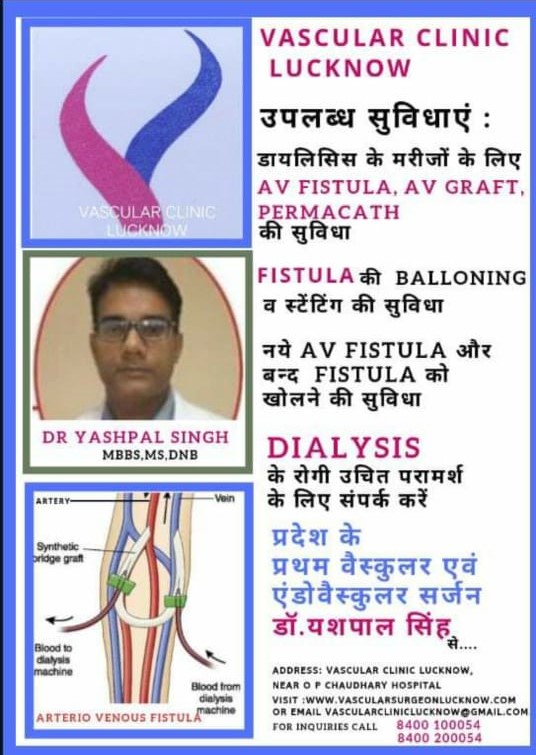DIALYSIS ACCESS
Home / Treatment /DIALYSIS ACCESS
Individuals with kidney dysfunction require long-term dialysis with functioning dialysis access. An arteriovenous [AV] fistula is used for the same. This surgically made connection between an artery (fast flow) and a vein (slow flow) enlarges (mature) the vein diameter which is used for dialysis, mostly 6-8 weeks post surgery. If dialysis isn’t an urgent requirement, one can place a temporary or permanent catheter, usually in the neck. However, it has a higher risk of infection and clotting or blockage.
Common sites of Arteriovenous [AV] Fistula -
The vascular specialist chooses sites based on artery and vein size and prior injections or thrombosis. Common sites are –
- Wrist
- Forearm
- Elbow
Alternatives to AV Fistula -
- If the fistula vein has been blocked earlier, or veins are unsuitable, complex vascular procedures like basilic vein bypass or artificial AV graft can be one. They are extensive surgical procedures done in the forearm or arm, generally under a nerve block.
- If AV Fistula or other complex surgical procedures are both not feasible or possible, Permcath, tunnelled dialysis catheters can be used.
- Peritoneal dialysis may also be used inplace of hemodialysis
Fistula care-
Commons guide for fistula –
- A thrill is usually felt and a bruit can be heard through a stethoscope over the fistula site.
- Pain/swelling or mild bruising may occur after the procedure, which usually settles 1-2 weeks later.
- Avoid BP check or blood samples from that arm.
- Regular wrist and fist exercises from the 2nd day.
- The vein will start appearing prominent by 6-8 weeks and can be used for dialysis.Though, in some patients, vein maturation may take more time and further evaluation by Doppler or fistula angiography
Symptoms to be aware of -
The diagnosis may be confused with renal stone gastritis. hernia or lumbar spine disease. However, Consulting a qualified vascular-endovascular surgeon with abdominal ultrasonography/CT scan would be recommended.
Treatment
After the surgery, watch out for these warning signs and consult the doctor as soon as possible.
- Bleeding: Bleeding may occur rarely, any time post operation because of fragile veins or infection. This requires urgent attention and may a repeat surgery or fistula or artery ligation.
- Blockage: Factors like Small-sized veins, low blood pressure, fever, dehydration or pressure at the fistula site can lead to fistula vein clotting and blockage (thrombosis). A repeat surgery or angioplasty may revive the fistula. Balloon angioplasty and the occasional use of stents are critical techniques used to prolong the dialysis fistula’s life. However, these veins may have blockage recurrences and require the repeat procedures to be performed.
- Massive swelling: Increasing swelling a few days post operation which doesn’t reduce after 2-3 weeks may require Doppler evaluation or angiography to detect large/central vein stenosis or occlusions. This needs treatment by angioplasty.
- Slow flow OR excess bleeding after the fistula usage are signs of fistula narrowing or fistula vein narrowing. Further evaluation by Doppler or angiography is needed. A repeat surgery or angioplasty may revive the fistula.
- Localised swelling (aneurysm): Localised pulsatile swelling requires urgent attention by specialist as an infected untreated aneurysm can cause severe bleeding.

